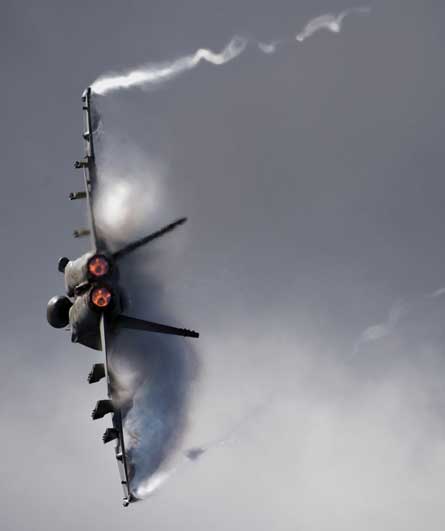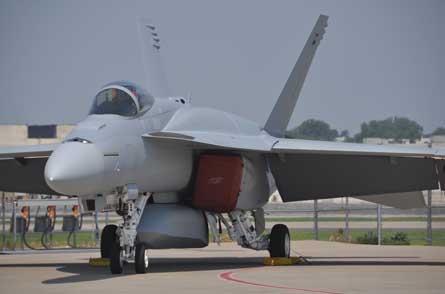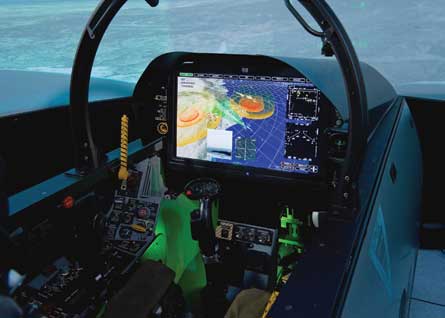Nearly 11 years ago, I had the chance to fly a Boeing F/A-18F at NAS Lemoore, in California's central valley. During my familiarisation flight, I was able to sample first-hand the Super Hornet's capabilities.
To reduce risk and speed up delivery to the US Navy fleet, the initial (Block I) Super Hornet's avionics suite was the same as that of the then operational F/A-18C/D. The aircraft I flew had a Raytheon APG-73 radar and an inertial navigation system that could be augmented with a GPS receiver. Although not previewed on my flight, the Block I aircraft also had the capability to employ the joint helmet-mounted cueing system (JHMCS). At the time, I had not been long out of the cockpit of the Lockheed Martin F-16, and was generally impressed by the Super Hornet's capabilities. In particular, I found the radar's ground-mapping capability to be excellent.
Since then, Boeing has not stood still, and an upgraded Block II Super Hornet - incorporating numerous improvements to sensors, weapons systems and cockpit - was fielded in 2007. The new standard brought with it a state-of-the-art active electronically scanned array (AESA) radar, an advanced tactical forward-looking infrared (ATFLIR) pod and a network capability.
 |
|---|
© US Navy |
The F/A-18E/F can employ weapons targeted by onboard sensors |
Raytheon's APG-79 AESA radar significantly increased the Super Hornet's air-to-air as well as air-to-ground capabilities. The electro-optical ATFLIR offers high-resolution capability that can be "slaved" to the AESA radar and JHMCS. Net-centric operations capability was improved by adding a multi-functional information distribution system/Link 16 digital communication system.
Recently, at Boeing's facility in St Louis, Missouri, I was able to fly a fixed-base Block II Super Hornet simulator. The front cockpit was much as I remembered it from my flight. The aft cockpit, however, had a larger 8in x 10in (20cm x 25cm) multi-function display instead of the previous 6in x 6in one. Also, the missionised aft cockpit can now be operated independently of the front cockpit.
As with all current tactical aircraft, the Super Hornet has significant hands-on-throttle-and-stick (HOTAS) capabilities. But what it lacked was 3D audio and voice command capability. The usefulness of voice commands may be debatable, but 3D audio can provide valuable spatial cues for threat reaction.
Although the Super Hornet is JHMCS capable, this was not used during my cockpit familiarisation flight. The JHMCS should be a great tactical asset, particularly during air combat manoeuvring. The accuracy of the off-boresight Raytheon AIM-9X Sidewinder infrared-guided missile is greatly enhanced by the ability to visually aim and shoot it at large off-axis angles.
My simulator sortie had air-to-air and air-to-ground elements, all flown near China Lake, just north of Edwards AFB. A final element involved three carrier landings at a notional ship off the coast of California.
 |
|---|
© Boeing |
Further improvements to the General Electric F414 engines will enhance the performance |
During the air-to-air engagements, it took me several minutes to get used to the Super Hornet's HOTAS controls. Cursor control in the F-16, for radar and other system slewing, is done with a thumb switch on the throttle. In the Super Hornet, it is done with the left middle finger, also on the throttle. Target designation can be done with a Z-axis/downward push on the slew button.
As a novice Super Hornet pilot, I found it difficult to keep the cursors over the target while designating it. I had the same problem when I flew a familiarisation flight in a Boeing F-15. I found using a separate button on the stick allowed me to designate targets without moving the cursors - an effective but much less elegant process than that employed by proficient F/A-18E/F pilots. Cueing symbols in the head-up display enabled me to visually acquire targeted aircraft rapidly, and the intuitive weapons symbology aided weapons employment.
Air-to-ground weapons delivery was practised from medium altitude. As with my actual flight in the Super Hornet, I found the Doppler beam sharpening mode of the radar built a very precise picture of the target environment. The APG-79's multi-tasking capabilities also allowed me to keep abreast of the air threats, while it drew a detailed picture of the China Lake airfield - our target area.
The Super Hornet is a formidable air-to-ground machine, with the ability to employ weapons targeted by onboard sensors (visual/radar/IR) as well as GPS- and laser-guided munitions. The two-seat Super Hornet with independent fore and aft cockpits should be a highly capable all-weather attack asset.
During the tactical portion of my simulator sortie, I felt at home in the Super Hornet's cockpit. Individual systems, the AESA radar in particular, are state of the art.
My overall feel for the pilot/vehicle interface, while it is effective and combat proven, was that it lags newer aircraft. Tactical information, for the most part, is presented on separate displays, forcing the pilot to do much of the fusion. This federated arrangement is no different from what I experienced when I flew a Block 60 F-16 simulator at Lockheed's Fort Worth facility in Texas in 2000. In 2007, I was able to fly a full-motion simulator for the Lockheed F-35 Joint Strike Fighter in both air-to-air and air-to-ground roles. The F-35's helmet-mounted display and large forward panel-mounted 19.6in x 8in display offered a wonderful palette to display truly fused tactical information.
 |
|---|
© Boeing |
In the cockpit, individual systems, such as the AESA radar in particular, are state of the art |
Engine and aircraft system information - readily available and automatically presented when needed - does not clutter the cockpit. The F-35's level of integration and sensor fusion was a generation ahead of what I experienced in the Block II Super Hornet and Block 60 F-16 simulator sessions.
But further slips to the F-35's initial operational capability date are a distinct possibility, while the Super Hornet is available now. Also, Boeing is hard at work developing cost-effective improvements and upgrades to the type.
Proposed improvements to the aircraft's General Electric F414 turbofan engines will enhance the Super Hornet's performance, and conformal fuel tanks will enable tactical operations at greater ranges.
A next-generation cockpit is also under development and has a very large 19in x 11in touch-sensitive display. I was able to fly a cockpit built around this display and can confirm that it provides an ideal palette to display fused tactical information.
The Super Hornet may have started life as a fourth-generation fighter, but Boeing's efforts should keep the type tactically relevant for years to come.
Source: Flight International























